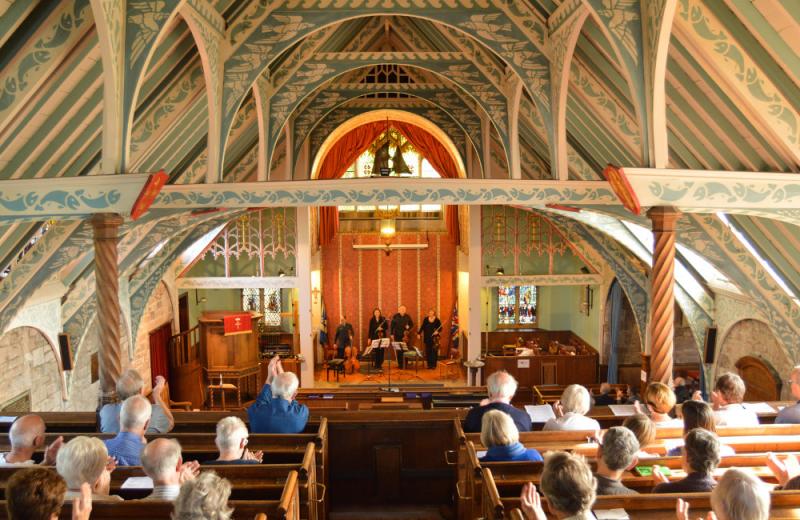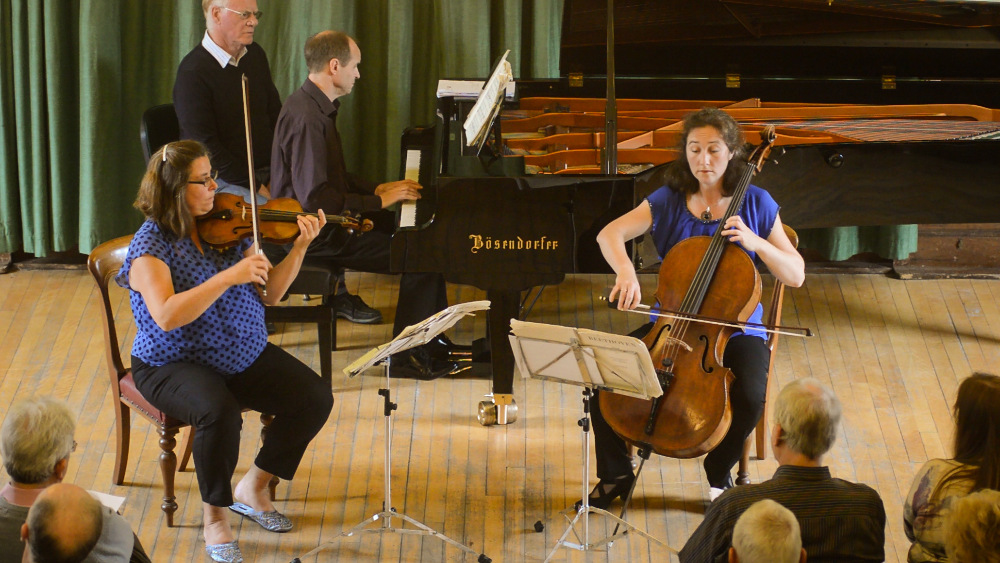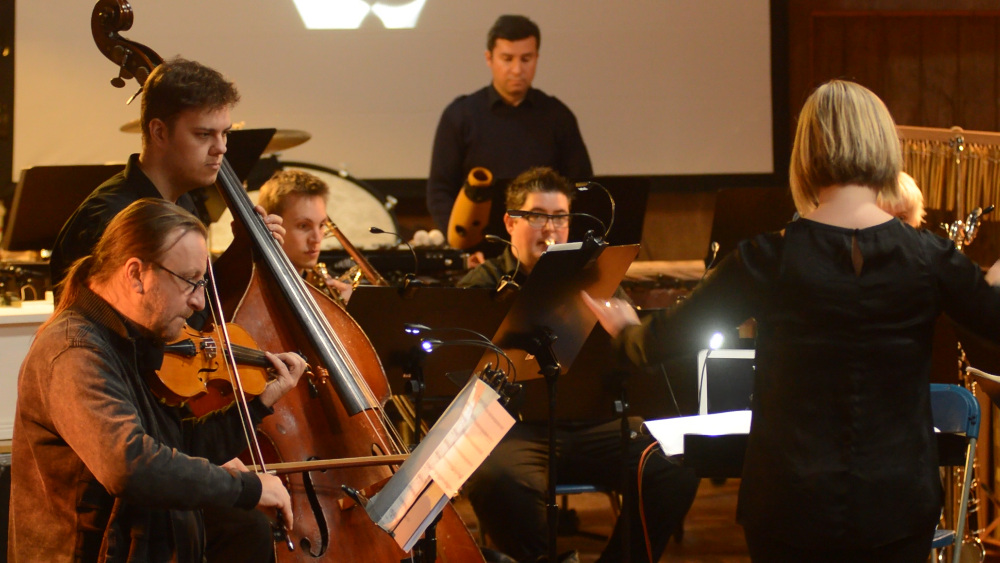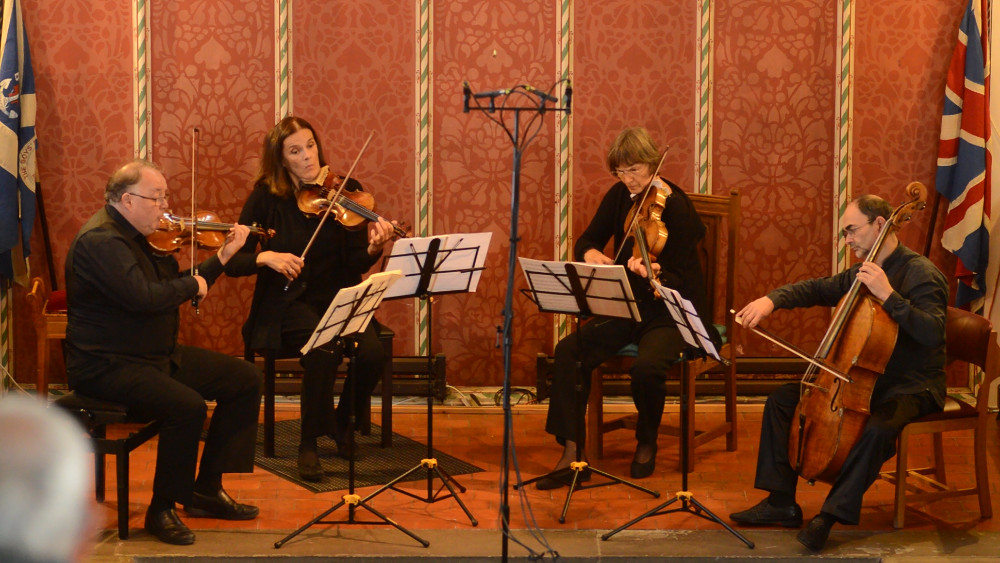Lammermuir Festival 2017 review - rich and deeply rewarding | reviews, news & interviews
Lammermuir Festival 2017 review - rich and deeply rewarding
Lammermuir Festival 2017 review - rich and deeply rewarding
Plenty to prokove, surprise and inspire in the East Lothian event

Increasingly, the Lammermuir Festival is – one audience member whispered conspiratorially to me – what East Lothian music lovers are switching to alongside the Edinburgh International Festival. It’s insidious to compare, of course – but still, you can see the attraction.
In this part of the world, during August and September listeners are spoilt for choice. And with performers of the calibre of the Quatuor Mosaïques, Steven Osborne, Tenebrae, Alban Gerhardt, John Butt and more – all of whom appeared at this year’s event – Lammermuir is undeniably snapping at the heels of its far vaster, elder neighbour.
Provocative in its own ways; casting new light on what might seem familiar; rich and deeply rewarding
And when you take into account the boundary-pushing variety among Lammermuir’s events this year – only its eighth outing – it’s no wonder the festival walked away with the Royal Philharmonic Society’s festival award for 2017. There were more traditional offerings, of course, but plenty to provoke, surprise and inspire as well.
Just take the film-meets-music offering from the Orlando Consort (also in East Lothian for a more traditional festival concert of Dufay, Bichois and others) in the resonant interior of St Mary’s Church, Haddington. Voices Appeared, on the festival’s opening Sunday, was a screening of Danish director Carol Theodor Dreyer’s remarkable 1928 silent movie The Passion of Joan of Arc, with a live, sung soundtrack of early 15th century choral music.
And even aside from the Orlando quintet’s exquisite performances, it worked wonderfully well on so many levels: sometimes simply as atmospheric background music, right through to the live voicing of specific chants and prayers from Dreyer’s ruthless inquisitors. And just like Dreyer’s images, the Consort’s accounts were ravishing in their beauty, but they also conveyed deeply held emotion. There was an unapologetic spiritual seriousness to the whole thing – one reflected in the hushed, reverential atmosphere of the evening overall – but it also showed just how powerful, and surprising, such an unexpected combination of movie and music can be. The Gould Piano Trio (pictured above) was one of the festival’s resident groups this year, giving a series of four morning concerts in Haddington’s Town House. The spacious room’s acoustics might have projected the trio’s playing a bit more forcefully than was ideal, but their Monday morning opening recital of Haydn, Britten and Ravel was bright, bubbling and focused all the same. Violinist Lucy Gould was strongly defined in Britten’s skittering early Suite for violin and piano – her figurations darting back and forth with pianist Benjamin Frith in the opening March – and they gave a big, passionate account of Ravel’s Piano Trio, graceful in its restrained opening movement, but seething with almost orchestral power in a vigorous finale.
The Gould Piano Trio (pictured above) was one of the festival’s resident groups this year, giving a series of four morning concerts in Haddington’s Town House. The spacious room’s acoustics might have projected the trio’s playing a bit more forcefully than was ideal, but their Monday morning opening recital of Haydn, Britten and Ravel was bright, bubbling and focused all the same. Violinist Lucy Gould was strongly defined in Britten’s skittering early Suite for violin and piano – her figurations darting back and forth with pianist Benjamin Frith in the opening March – and they gave a big, passionate account of Ravel’s Piano Trio, graceful in its restrained opening movement, but seething with almost orchestral power in a vigorous finale.
The Gould’s fifth and final festival concert took place amid the generous acoustics of Stenton Parish Church on the closing Saturday, with more Haydn – a cheeky, sparkling Piano Trio in E minor, Hob.XV:12 – and a gloriously expansive Beethoven Archduke Trio to close, as warm-hearted as it was cleanly articulated. In between came a brand new piece – Sunrises, by the festival’s composer in association Stuart MacRae. The first in a projected cycle of three works inspired by the Prometheus myth, it contrasted brilliant, clangorous gestures right at the top of the trio’s registers – coming to rest on unexpected, ear-tweaking triads – with gnomic pizzicatos or fragmented melodies lower on the instruments. Everything seemed in a constant state of flux and transformation, repetition and not-quite-repetition – just like the Titan’s unending daily ordeal of having his liver consumed by an eagle. All three instruments contributed to a single idea of remarkable focus and, most importantly, grabbed the attention in what was an immediately captivating, sometimes mesmerising work. There had been more contemporary music the previous day, when new music group the Red Note Ensemble (pictured above) – bolstered by young European players from the Red Note Advanced Academy – were crammed into the Granary at Eastfield Farm, Whittingehame, for two theatrical pieces by David Sawer. Hollywood Extra was a rather arch, appropriately Hollywood-style soundtrack to Robert Florey’s strange, semi-abstract 1928 silent movie The Life and Death of 9413 - A Hollywood Extra, while The Lighthouse Keepers, a collaboration with playwright David Harrower, was virtually an opera for the imagination in its dark tale for two speaking actors and ensemble.
There had been more contemporary music the previous day, when new music group the Red Note Ensemble (pictured above) – bolstered by young European players from the Red Note Advanced Academy – were crammed into the Granary at Eastfield Farm, Whittingehame, for two theatrical pieces by David Sawer. Hollywood Extra was a rather arch, appropriately Hollywood-style soundtrack to Robert Florey’s strange, semi-abstract 1928 silent movie The Life and Death of 9413 - A Hollywood Extra, while The Lighthouse Keepers, a collaboration with playwright David Harrower, was virtually an opera for the imagination in its dark tale for two speaking actors and ensemble.
There was a bristling immediacy to both works in conductor Holly Mathieson’s precise, vividly characterised accounts – made even stronger by the Granary’s somewhat restricted space. In between came another remarkable new work, Thomas Butler’s Limnology, all Scelsi-like microtonal waverings and throbbing, pregnant textures, inspired by the impact of climate change on glacial rivers. Alongside the Gould Piano Trio, the festival’s other resident artists for 2017 were the period-instrument Quatuor Mosaïques (pictured above), who gave three concerts across East Lothian venues. Their Tuesday afternoon offering – amid the Arts and Crafts splendour of the Chalmers Memorial Church in Port Seton – also offered a nod, as festival co-artistic director James Waters explained, to probably the sole composer to put the Lammermuir hills on the classical map: Gaetano Donizetti, whose Lucia di Lammermoor is based on Walter Scott. The first discoveries from Donizetti’s String Quartet No. 17 were that it even existed, and indeed had 17 bedfellows (he wrote 18 quartets in total). Later surprises were its adventurous textures and harmonies, its guitar-like strummings, and how shamelessly he seemed to have pilfered from Rossini in its energetic finale (drawing a few titters from the audience).
Alongside the Gould Piano Trio, the festival’s other resident artists for 2017 were the period-instrument Quatuor Mosaïques (pictured above), who gave three concerts across East Lothian venues. Their Tuesday afternoon offering – amid the Arts and Crafts splendour of the Chalmers Memorial Church in Port Seton – also offered a nod, as festival co-artistic director James Waters explained, to probably the sole composer to put the Lammermuir hills on the classical map: Gaetano Donizetti, whose Lucia di Lammermoor is based on Walter Scott. The first discoveries from Donizetti’s String Quartet No. 17 were that it even existed, and indeed had 17 bedfellows (he wrote 18 quartets in total). Later surprises were its adventurous textures and harmonies, its guitar-like strummings, and how shamelessly he seemed to have pilfered from Rossini in its energetic finale (drawing a few titters from the audience).
The Mosaïques complemented the Donizetti oddity, enjoyable though it was, with Mozart and Haydn, both gloriously rich despite the group’s carefully infrequent vibrato, sparkling with a raw edge in their rushing figurations and unforced in their supple rhythmic freedom. Indeed, the Mosaïques’ performance – provocative in its own ways; casting new light on what might seem familiar; rich and deeply rewarding – felt like a neat parallel for what the broader festival had achieved.
The future of Arts Journalism
You can stop theartsdesk.com closing!
We urgently need financing to survive. Our fundraising drive has thus far raised £49,000 but we need to reach £100,000 or we will be forced to close. Please contribute here: https://gofund.me/c3f6033d
And if you can forward this information to anyone who might assist, we’d be grateful.

Subscribe to theartsdesk.com
Thank you for continuing to read our work on theartsdesk.com. For unlimited access to every article in its entirety, including our archive of more than 15,000 pieces, we're asking for £5 per month or £40 per year. We feel it's a very good deal, and hope you do too.
To take a subscription now simply click here.
And if you're looking for that extra gift for a friend or family member, why not treat them to a theartsdesk.com gift subscription?
more Classical music
 theartsdesk at the Lahti Sibelius Festival - early epics by the Finnish master in context
Finnish heroes meet their Austro-German counterparts in breathtaking interpretations
theartsdesk at the Lahti Sibelius Festival - early epics by the Finnish master in context
Finnish heroes meet their Austro-German counterparts in breathtaking interpretations
 Classical CDs: Sleigh rides, pancakes and cigars
Two big boxes, plus new music for brass and a pair of clarinet concertos
Classical CDs: Sleigh rides, pancakes and cigars
Two big boxes, plus new music for brass and a pair of clarinet concertos
 Waley-Cohen, Manchester Camerata, Pether, Whitworth Art Gallery, Manchester review - premiere of no ordinary violin concerto
Images of maternal care inspired by Hepworth and played in a gallery setting
Waley-Cohen, Manchester Camerata, Pether, Whitworth Art Gallery, Manchester review - premiere of no ordinary violin concerto
Images of maternal care inspired by Hepworth and played in a gallery setting
 BBC Proms: Barruk, Norwegian Chamber Orchestra, Kuusisto review - vague incantations, precise laments
First-half mix of Sámi songs and string things falters, but Shostakovich scours the soul
BBC Proms: Barruk, Norwegian Chamber Orchestra, Kuusisto review - vague incantations, precise laments
First-half mix of Sámi songs and string things falters, but Shostakovich scours the soul
 BBC Proms: Alexander’s Feast, Irish Baroque Orchestra, Whelan review - rapturous Handel fills the space
Pure joy, with a touch of introspection, from a great ensemble and three superb soloists
BBC Proms: Alexander’s Feast, Irish Baroque Orchestra, Whelan review - rapturous Handel fills the space
Pure joy, with a touch of introspection, from a great ensemble and three superb soloists
 BBC Proms: Moore, LSO, Bancroft review - the freshness of morning wind and brass
English concert band music...and an outlier
BBC Proms: Moore, LSO, Bancroft review - the freshness of morning wind and brass
English concert band music...and an outlier
 Willis-Sørensen, Ukrainian Freedom Orchestra, Wilson, Cadogan Hall review - romantic resilience
Passion, and polish, from Kyiv's musical warriors
Willis-Sørensen, Ukrainian Freedom Orchestra, Wilson, Cadogan Hall review - romantic resilience
Passion, and polish, from Kyiv's musical warriors
 BBC Proms: Faust, Gewandhausorchester Leipzig, Nelsons review - grace, then grandeur
A great fiddler lightens a dense orchestral palette
BBC Proms: Faust, Gewandhausorchester Leipzig, Nelsons review - grace, then grandeur
A great fiddler lightens a dense orchestral palette
 BBC Proms: Jansen, Royal Concertgebouw Orchestra, Mäkelä review - confirming a phenomenon
Second Prom of a great orchestra and chief conductor in waiting never puts a foot wrong
BBC Proms: Jansen, Royal Concertgebouw Orchestra, Mäkelä review - confirming a phenomenon
Second Prom of a great orchestra and chief conductor in waiting never puts a foot wrong
 BBC Proms: Royal Concertgebouw Orchestra, Mäkelä review - defiantly introverted Mahler 5 gives food for thought
Chief Conductor in Waiting has supple, nuanced chemistry with a great orchestra
BBC Proms: Royal Concertgebouw Orchestra, Mäkelä review - defiantly introverted Mahler 5 gives food for thought
Chief Conductor in Waiting has supple, nuanced chemistry with a great orchestra
 Dunedin Consort, Butt / D’Angelo, Muñoz, Edinburgh International Festival 2025 review - tedious Handel, directionless song recital
Ho-hum 'comic' cantata, and a song recital needing more than a beautiful voice
Dunedin Consort, Butt / D’Angelo, Muñoz, Edinburgh International Festival 2025 review - tedious Handel, directionless song recital
Ho-hum 'comic' cantata, and a song recital needing more than a beautiful voice
 Classical CDs: Dungeons, microtones and psychic distress
This year's big anniversary celebrated with a pair of boxes, plus clarinets, pianos and sacred music
Classical CDs: Dungeons, microtones and psychic distress
This year's big anniversary celebrated with a pair of boxes, plus clarinets, pianos and sacred music

Add comment